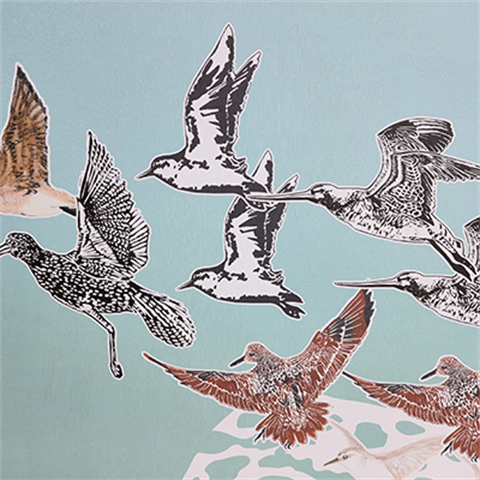Wall of Wings

Migratory shorebirds of Hobsons Bay
Hobsons Bay has over 20km of beaches and foreshore areas. It also has five creek systems, remnant native grasslands and important flora and fauna habitat including internationally significant wetlands that provide important feeding and roosting areas for many species of migratory shorebirds including the Bar-tailed Godwit, Grey Plover, Latham’s Snipe, Pacific Golden Plover, Common Greenshank, Common Sandpiper, Double-banded Plover, Curlew Sandpiper, Great Knot, Eastern Curlew, Lesser Sand Plover, Sharp-tailed Sandpiper, Marsh Sandpiper and Red-necked Stint.
Migratory shorebirds are our most amazing travellers! We are so lucky that they visit Hobsons Bay every year, spending October to May on our shores before making the 25,000km round-trip along the East Asian-Australasian Flyway to and from their main arctic breeding grounds in Siberia and Alaska. Over a lifetime of such journeys, many of these small birds will fly more miles than from the earth to the moon and back!
You can spot them at many places in Hobsons Bay including:
- Stony Creek Backwash
- Sandy Point Nature Reserve
- Point Gellibrand – Shelly Beach
- Jawbone Flora and Fauna Reserve
- Paisley-Challis Wetlands
- Altona Coastal Park, Ford crossing
- Seaholme Foreshore
- Truganina Park/Laverton Creek estuary
- Truganina Swamp
Use this handy Birds of Hobsons Bay's Coastline guide on your next bird-watching adventure.
Sadly migratory shorebirds are some of our most endangered group of birds. To help ensure that Hobsons Bay is a safe place for these international travellers to return to you can:
- contain and restrain pets from accessing important shorebird habitat
- avoid excessive disturbance through noise and visitation where shorebirds occur
- tell your family, friends, and colleagues about these amazing birds
- respect habitat by disposing of rubbish responsibly and picking up after pets
- join one of Hobsons Bay’s many local environments volunteer community groups
- eliminate using pesticides where possible
- adhere to signage within our reserves and foreshore areas
- participate in one of Birdlife Australia’s monitoring programs
The Wall of Wings at Altona Meadows Library and Learning Centre
The Wall of Wings was initiated by Coffs Coast artist Penelope Lawry in 2019 as a way for artists and art groups to join the Overwintering Project, an environmental art project that unites artists around Australia to raise awareness our most endangered group of birds, migratory shorebirds, and their habitat.
Penelope’s idea was to create a beautiful mass installation of swirling birds, recreating the wonder of flocks of migrating shorebirds! Today, in response to international callouts, over 250 artists of all ages and 9 school groups have contributed prints of migratory shorebirds that together form a magnificent Wall of Wings – a multi-species flock of the birds that connect the world!
The Altona Meadows Library Wall of Wings features digitised images of original prints (e.g. linocuts and etchings) by a selection of the Wall of Wings artists, some of whom undertook printmaking workshops at Woods Street Art Space in Laverton. Their artworks were part of an exhibition at the Louis Joel Gallery in Altona, in 2022. The artists whose work you see here are: Miriam Anderson, Xander B., Toz Dadswell, Emma Davies, Libby Derham, Bridget Farmer, Kate Gorringe-Smith, Penelope Lawry, Hannah Lewis, Larissa MacFarlane, Elise Pahlow, Elle Reece, Honi Reifler, Trudy Rice, Fiona Taylor, Hannah Terry, Vashti Thompson, Vicki Tyrrell and Amanda Western.
The Overwintering Project was initiated in 2017 by Melbourne artist Kate Gorringe-Smith to raise awareness for our amazing migratory shorebirds. This multi-faceted environmental art project has opportunities for people of all ages to help people experience the wonder of our migratory shorebirds and to help ensure their survival.
For further information on the Overwintering Project, click here.